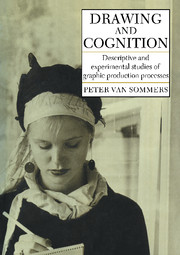Book contents
- Frontmatter
- Contents
- Preface
- 1 Basic executive constraints in drawing
- 2 Maintaining paper contact, anchoring, and planning
- 3 The reproduction of rectilinear figures
- 4 The production of curvilinear forms
- 5 The impact of meaning on executive strategies
- 6 Simple representational drawing
- 7 Difficult graphic tasks: A failure in perceptual analysis?
- 8 Stability and evolution in children's drawings
- 9 Innovations, primitives, contour, and space in children's drawings
- 10 Children's repeated drawings: How are innovations coded?
- 11 The pragmatics of everyday graphic production
- References
- Index
3 - The reproduction of rectilinear figures
Published online by Cambridge University Press: 07 October 2011
- Frontmatter
- Contents
- Preface
- 1 Basic executive constraints in drawing
- 2 Maintaining paper contact, anchoring, and planning
- 3 The reproduction of rectilinear figures
- 4 The production of curvilinear forms
- 5 The impact of meaning on executive strategies
- 6 Simple representational drawing
- 7 Difficult graphic tasks: A failure in perceptual analysis?
- 8 Stability and evolution in children's drawings
- 9 Innovations, primitives, contour, and space in children's drawings
- 10 Children's repeated drawings: How are innovations coded?
- 11 The pragmatics of everyday graphic production
- References
- Index
Summary
There are two ways in which to draw a simple horizontal line – from left to right and from right to left. When lines are combined together in closed figures such as triangles, rectangles, and rhombuses, the number of possible construction sequences rises steeply. For example, if we ignore whether or not the drawing instrument is raised from the paper at the corners, there are 48 ways to draw a triangle; if we include the option of raising the pencil, the number of possible courses of action rises to 192. The corresponding values for quadrilaterals are much higher.
There is, furthermore, a great variety of proportions and orientations of figures like triangles, so any attempt to provide a comprehensive formula for specifying how the figures are produced by subjects may seem unattainable. Fortunately subjects do not exploit more than a tiny fraction of the courses of action available, and the principles governing their approaches are quite general, so it is possible to utilize the same methods of analysis and emerge with the same laws not only across all types of triangles in all their orientations, but across all other rectilinear figures, including solids.
The analysis of plane figures
The original attack on the problem was to collect copying performances on a great variety of abstract forms exploiting differences not only in basic geometry and orientation, but in the type of line used (plain, interrupted, oscillating) and the various combinations of forms – concentric, overlapping, and so on.
- Type
- Chapter
- Information
- Drawing and CognitionDescriptive and Experimental Studies of Graphic Production Processes, pp. 52 - 71Publisher: Cambridge University PressPrint publication year: 1984
- 1
- Cited by



